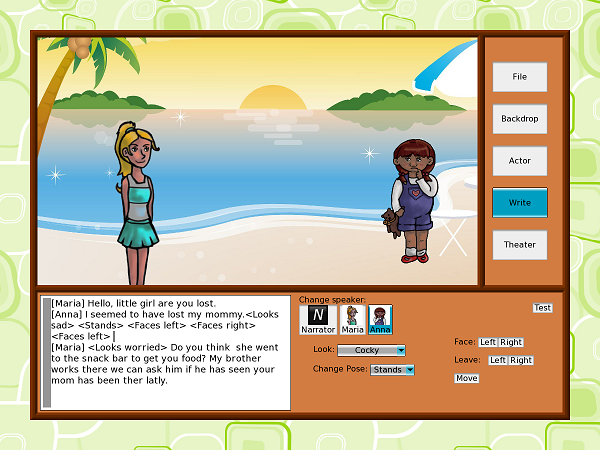Broadway: Difference between revisions
Jump to navigation
Jump to search
(→Usage) |
|||
| Line 1: | Line 1: | ||
Broadway is a remake of the classic computer game [http://en.wikipedia.org/wiki/Hollywood_(video_game) "Hollywood" by Theatrix], and can be considered a spiritual successor to the [http://wiki.sugarlabs.org/go/Activities/Story_Builder Story Builder] software. Users create a story by choosing a backdrop, creating actors, and then writing a script. Using animation and the native Text-to-Speech software, the story comes alive. |
Broadway is a remake of the classic computer game [http://en.wikipedia.org/wiki/Hollywood_(video_game) "Hollywood" by Theatrix], and can be considered a spiritual successor to the [http://wiki.sugarlabs.org/go/Activities/Story_Builder Story Builder] software. Users create a story by choosing a backdrop, creating actors, and then writing a script. Using animation and the native Text-to-Speech software, the story comes alive. |
||
== Example Screenshot == |
|||
| ⚫ | |||
== Usage == |
== Usage == |
||
| ⚫ | |||
There are three main User Interface components in Broadway: |
|||
* Stage: This is where the Actors and Backdrop appear. Any animation and action takes place here. |
|||
* Tabs: This contains buttons that switch the currently active Panel. |
|||
* Panels: This is where the 5 different Panels appear. A Panel is a collection of controls. |
|||
** File Panel: Contains controls to save, load, and create Scripts. You can also modify metadata about the current Script from here, including the title, author, and a description. |
|||
** Backdrop Panel: Contains controls to change the Backdrop of this Script. |
|||
** Actor Panel: Contains controls to add, remove, and edit Actors. You can adjust a variety of settings for each Actor, such as their name, skin, voice. |
|||
** Script Panel: Contains controls to write the Script. Besides the dialogue, you can also direct Actor's to perform actions such as moving around, changing pose and expression, or leaving the stage. |
|||
** Theater Panel: Contains controls to watch the current Script. |
|||
== Development == |
== Development == |
||
Revision as of 22:22, 2 July 2012
Broadway is a remake of the classic computer game "Hollywood" by Theatrix, and can be considered a spiritual successor to the Story Builder software. Users create a story by choosing a backdrop, creating actors, and then writing a script. Using animation and the native Text-to-Speech software, the story comes alive.
Example Screenshot
Usage
There are three main User Interface components in Broadway:
- Stage: This is where the Actors and Backdrop appear. Any animation and action takes place here.
- Tabs: This contains buttons that switch the currently active Panel.
- Panels: This is where the 5 different Panels appear. A Panel is a collection of controls.
- File Panel: Contains controls to save, load, and create Scripts. You can also modify metadata about the current Script from here, including the title, author, and a description.
- Backdrop Panel: Contains controls to change the Backdrop of this Script.
- Actor Panel: Contains controls to add, remove, and edit Actors. You can adjust a variety of settings for each Actor, such as their name, skin, voice.
- Script Panel: Contains controls to write the Script. Besides the dialogue, you can also direct Actor's to perform actions such as moving around, changing pose and expression, or leaving the stage.
- Theater Panel: Contains controls to watch the current Script.
Development
Packages used:
- Pygame
- Spyral
- PGU
- Simplejson
Broadway was created using Pygame. Spyral is used to simplify the handling of Sprites in the Theater. A modified version of PGU is used to handle the user interface. Finally, Scripts are currently stored using JSON, requiring the Simplejson library.
Planned Features
- More translations
- Spellcheck
- Grammarcheck
- Export to Youtube
- More of the existing content: actors, backdrops, twists, emotions, voices, etc.
- Download content button (from central repository)
- More example stories
- Better text editing features (copy/paste, etc.)
- Props that actors can interact with
- Animations
- Sound Effects and Musical Stings
Requested Features
- ...?
Author
Austin Cory Bart, for his undergraduate thesis work at the University of Delaware with Dr. Lori Pollock.
